Once upon a time in Aceh – Notes on the release of hostages
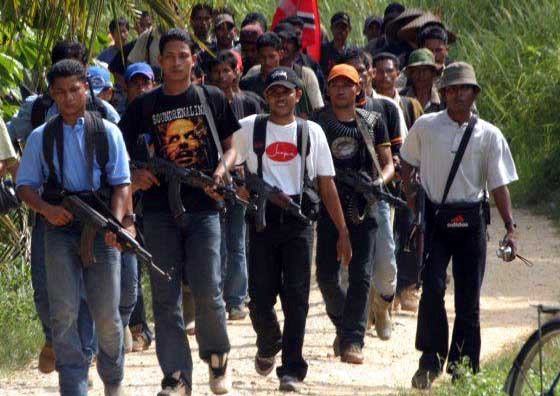
Free Aceh Movement guerrillas (Picture by Nani Afrida)
By Eddy Suprapto,
Chairman Alliance of independent journalists 2003-2005
Editor in Chief RCTI 2014-2016
JAKARTA: Post-reform, there are a number of things in the political field that deserve an important note. Some of them were about the removal of Abdurrahman Wahid by the House of Representatives.
(DPR) who was later replaced by his deputy, Megawati Soekarno Putri. Apart from that, there are also upheavals in a number of areas, such as in Papua, Ambon, and Aceh. In 2003, arguably the most prominent was the Aceh conflict, in which the Free Aceh Movement (GAM) wanted to pursue its long-standing dream of independence. President Megawati’s government is showing signs of being impatient for dialogue with GAM. Finally, on 19 May 2003, the government held an Integrated Operation because GAM was deemed to have rejected the ultimatum to accept Special Autonomy for Aceh under the Unitary State of the Republic of Indonesia (NKRI).
The imposition of martial law status in Aceh changed the lives of the Acehnese from being open to being more careful. Access to information is also hampered, because all journalists who cover Aceh are required to report every morning. Space, mass media movement is limited and can get access if permission is obtained from the Regional Military Emergency Commander and Indonesian national army (TNI ) Operations Command. Even the mass media are not explicitly allowed to develop news and quote GAM statements. In his statement, the Military Emergency Authority of the Military Region of Iskandar Muda Nangroh Aceh Darusalam Major General Endang Suwarya on May 20, 2003 in Banda Aceh said, “I hope journalists write within the framework of the Unitary State of the Republic of Indonesia. However, I ask not to make GAM big.” Under Military Emergency Pressure Martial Law situation puts the media in an awry position.
The martial law government has special laws and mechanisms to regulate social life, including media coverage. Moreover, what is happening in Aceh is a guerrilla war. In such a war, what is needed is not only the mobilization of the army, but also publicity to influence the strength and morale of the opponent and the support of the people. Martial Law authorities have come to the conclusion that winning a war without winning media coverage is impossible.
The media were then consolidated to participate in basic military training at Sangga Buana, Karawang, West Java. Many journalists were given boots and military attire. The Military Emergency Authority requires the media to prioritize reporting within the framework of the Unitary State of the Republic of Indonesia. The reporting mechanism is centered and centralized in the military emergency command center office in the media center.
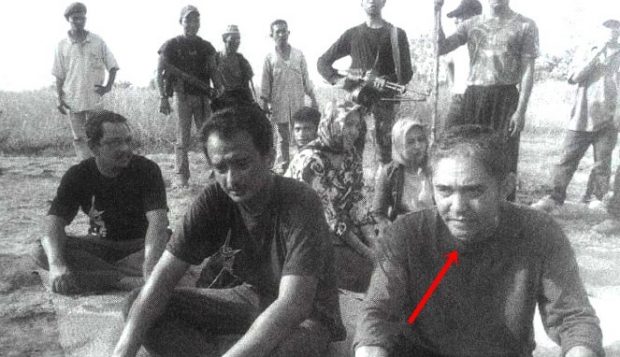
Ersa dan Ferry Journalists RCTI TV held hostage by Free Aceh Movement.
During the military emergency period, news coverage was not balanced. The Free Aceh Movement (GAM) also changed the pattern of information by placing 9 media spokespersons in 9 areas. This method of disseminating information goes against Indonesian national army (TNI) centralized information model. The journalist’s work pattern is the same, namely centered around the media center. If there is coverage of refugees, a journalist must report and obtain permission from the regional martial law authorities. With this condition, only a small number of media perform their journalistic work in a balanced way.
In practice, the coverage of GAM is not balanced. According to the late GAM Commander for East Aceh Ishak Daud in an interview on 19 May 2004, “We feel that the media is not impartial in reporting to us. The media only reported that the TNI never confirmed it with us.” The closed access to communication with GAM and the pressure of the Military Emergency status gave rise to distrust. Polarization occurred between the military and civilians, journalists from Jakarta and journalists from Aceh.
The impatient Free Aceh Movement (GAM) group began to block journalists’ cars, especially television. Free Aceh Movement (GAM) suspects that many media circles have been infiltrated by TNI intelligence. The pattern of deterrence began to be designed mainly by troops under the command of Teuku Ishak Daud operating in East Aceh.
According to Ishak Daud, “We were intercepted because we received information that the media was infiltrated by intelligence.” This ambush also caused Ersa Siregar and Ferry Santoro to become hostage victims, June 29, 2003. At that time, RCTI TV journalists were covering the condition of refugees in East Aceh. It was then that the two of them were intercepted by GAM troops. When confronted, along with the two of them were the wives of Indonesian Air Force soldiers and Rachmat Syah, the driver. Their car was stopped and forced out. “GAM suspected that journalists were infiltrated by TNI intelligence. It just so happened that our car passed by. We were confronted by 6 people with long-barreled AK-47s and short-barreled weapons,” said Ferry Santoro.
After that, they were taken to the village of Panten Raeyek, East Aceh”. The hostage-taking of Ersa Siregar and Ferry Santoro lasted 11 months. GAM spokesman Ishak Daud always said, “We wanted to let go but the time and place were never right. We could have let them go but in the middle of the road they were both shot by the TNI, the name GAM is gone.” The news of the hostage-taking spread widely, including internationally.
At the same time, the Indonesian national army (TNI) intensified pursuit and ambushes. Because GAM is very integrated with the community and most of East Aceh is bordered by the sea, the pursuit took 6 months for the TNI to ambush Ishak Daud’s troops. Until finally there was a gun battle between the Marines and GAM combat units on the Malehan river, Simpang Ulim, East Aceh, December 29, 2003.
“At that time we had just had breakfast and not many GAM people were guarding us. There is one young person and the rest are old,” said Ferry. “Suddenly there was a burst of gunfire. I immediately jumped to the left of the hut and crawled away from the location. It was only the next day that I received news that Ersa had died,” said Ferry. “I was crying and all my joints were paralyzed.” The news of Ersa’s death raised questions, was she killed by GAM or TNI bullets? Army Chief of Staff General Ryamizard Ryacudu explained to a reporter for RCTI TV in Denpasar, December 30, 2003, “The deceased was hit by a bullet from a TNI soldier. This is because Ersa is with GAM.” Ersa’s death became the culmination of cases of violence against journalists in the midst of the conflict in Aceh.
From Journalist to Negotiator
The day after the funeral of the late Ersa Siregar, the board of the Alliance of Independent Journalists (AJI) gathered and formulated a resolution to the Aceh Fery Santoro hostage crisis with a peaceful journalism approach. Based on the evaluation, Ersa’s death was a failure of all parties, including the government, GAM, journalist organizations and the Red Cross. Because there is no mutual trust, all are pessimistic that there will be peace.
Because of that, in order to build trust which is expected to stimulate optimism for peace, lobbying has been started. Inter-institutional meetings have begun, between AJI and RCTI, AJI with regional institutions, and AJI with the parent International Federation of Journalists (IFJ). Journalists’ knowledge is no longer just an interview, but now must be added to the ability to lobby. It is intended to generate mutual trust between institutions and optimism for peace. Efforts to communicate with the government are intensively carried out.
On December 18, 2003, eleven days before Ersa’s death, AJI sent a letter to President Megawati to release the two. Apart from AJI, similar pressures have come from AJI’s partners, such as Australia, the Philippines, South Korea, Taiwan, Japan, Brussels, Britain and the United States. A letter urging the release of the hostages was conveyed through the Head of the Presidential Press and Media Bureau, Garibaldi Sujatmiko, at Bina Graha, Jakarta, December 19, 2003. However, the Presidential Palace did not move much to comply with these demands.
IFJ President Christopher Warren criticized President Megawati and said, “The government’s inaction in facilitating the release of the two journalists is inexcusable and incomprehensible.” That is one of the issues in Chistopher Warren’s letter to President Megawati.
Having reached a dead end in dialogue with Megawati’s government, AJI tried to lobby GAM President Hasan Tiro in Sweden. AJI requested the assistance of the Secretary General of IFJ Aidan White to meet Hasan Tiro in Stochom Sweden, January 2004. Aidan White, accompanied by the President of the Swedish Journalist, held a meeting with Hasan Tiro. During the meeting, a peace agreement was reached, namely that GAM agreed to release Ferry Santoro. However, GAM also asked the media to report in a balanced manner and participate in promoting peace efforts in Aceh. Hasan Tiro signed the tree point agreement.
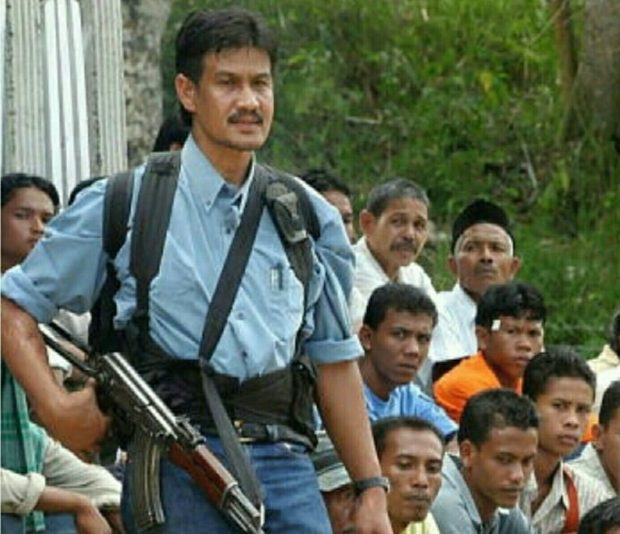
Ishak Daud Commander of the Fee Aceh Movement District East Aceh (Picture by By Nani Afrida)
Armed with the peace agreement from the Aceh Wali Nangro Darussalam Teuku Hasan Tiro, AJI began making telephone contact with the East Aceh Commander Teuku Ishak Daud. At first, Ishak Daud did not believe that AJI had a peace agreement from the President of GAM.
So it was agreed that a teleconference was witnessed by local and foreign media between the Chairperson of AJI Indonesia, the Secretary General of IFJ and Isak Daud at the Le Meredian hotel, Jakarta, May 6, 2004. Ishak Daud promised to release Ferry Sontoro. The net of the peace agreement became more and more bright when they met with the Indonesian Natioanal Army (TNI) Information Center Major General Sjafrie Sjamsoeddin in Cilangkap, Jakarta, May 10, 2004.
During the meeting the Chairperson of AJI Indonesia and the Secretary General of IFJ hoped that the TNI would help AJI open a dialogue room with GAM so that Ferry could be released. Sjafrie agreed with AJI’s proposal and would coordinate it with the Aceh Military Commander Tengku Umar, Major General Endang Suwarya.
AJI’s meeting with the director of International Red Cross in Jakarta was also conducted on an incentive basis. Meetings with Boris Michell, director of ICRC Jakarta, are held almost every week. At that time, the ICRC was already pessimistic about peace efforts in Aceh, especially regarding the release of hostages. Boris said that on February 11, 2004, the government and GAM had agreed on the release of the hostages. The plan failed.
In February 2004, GAM and TNI engaged in a gun battle and the TNI succeeded in freeing two hostages, the wives of the TNI, who were with Ersa and Ferry. In the meeting with the Indonesian Red Cross, especially the PMI secretary general, Yan Iskandar, there was a tone of pessimism. Yan spoke about the failed ceasefire and the planned release of the hostages in February.
The ICRC and PMI do not believe that GAM will release Ferry. They asked Coordinating Minister for Political, Legal and Security Affairs Susilo Bambang Yudhoyono to come to Aceh. In fact, both the President and the Coordinating Minister for Political, Legal and Security Affairs do not believe that GAM is keeping its promises. I told Boris, Yan and the secretary of the Coordinating Minister for Political, Legal and Security Affairs Sudi Silahi that AJI had guaranteed release from Hasan Tiro and that there was an agreement from Ishak Daud that the release would take place on May 14, 2004.
Forming a Special Team
Considering the selection of this particular team, it seemed like a no-brainer. The liberation effort was carried out by the Chair and Secretary General of the Alliance of Independent Journalists. It is conceivable that if the two of them were held hostage, the wheels of the organization would be paralyzed. But our considerations at that time chose Nezar Patria to join the team because he was from Aceh and could communicate in Acehnese.
The choice to invite former AJI Secretary General Solahudin was also due to his consideration that he had experience in releasing hostages in Papua when Swedish journalists were held hostage to Free Papua (OPM), in 2003. Another AJI member who participated as a reporter covering this release is a former Republika journalist. Husni Arifin. The four of us flew to the city of Medan on May 12, 2004. Meanwhile, the team from RCTI was divided into two. The first team, Imam Wahyudi, had already departed from the Banda Aceh post point for Langsa.
The Imam’s task is to convince Pangdam Tengku Umar Endang Suwarya that the negotiations this time are serious. Along with Imam, the Banda Aceh and Lhoksumawe Red Cross also came. The second RCTI TV team was led by Teguh Juwarno, who was then RCTI’s Corporate Secretary. In the meeting, it was agreed to sleep in the same hotel, then make a scenario for the release stage.
We also included Ishak Daud’s wife, who had been living in Bekasi (a city east of Jakarta) with Ishak Daud’s 2-year-old son. Isaac Daud’s wife was accompanied by Isaac Daud’s lawyer, Hamzah. We include Isaac Daud’s wife because it is a prerequisite for Ferry’s release. AJI also initiated a meeting between Ishak Daud’s wife and Ferry’s wife in Jakarta. This meeting is an attempt to find a way of peace. A figure who is no less important and becomes the key to the negotiations is a Chinese person named Alfian. At first Alfian did not want to see me. I had to bring the name of the conglomerate in Jakarta as a keyword so that Alfian would meet me.
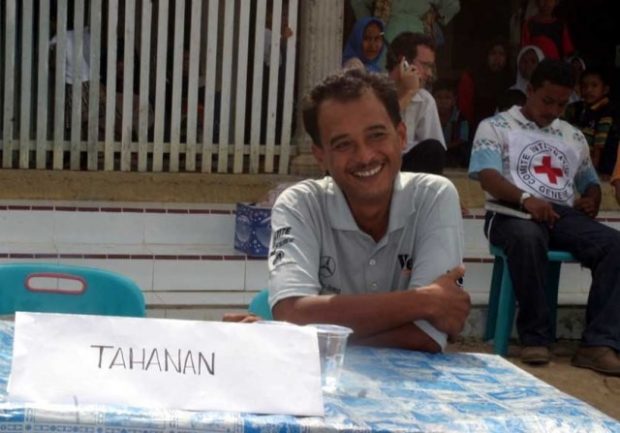
Ferry Santoro was held hostage by GAM for 11 months (Picture by Nani Afrida)
Meeting Alfian is very unique and important. He helped build mutual trust between GAM and TNI. According to Alfian, he is close to GAM and the TNI. It turns out that Alfian manages oil palm fields with an agreement of 25 percent for GAM and 25 percent for the TNI. Imam Wahyudi suggested looking for Alfian as a way of negotiating with Isaac Daud. His role was very important in re-establishing trust between GAM and the TNI.
The government delegation from Jakarta, the Secretary of the Coordinating Minister for Political, Legal and Security Affairs Major General Retired Sudi Silalahi and the late Chairman of PMI Marie Muhammad. All the group moved to Langsa. All media and news are focused on the liberation process. The negotiations this time were out of the ordinary for a hostage settlement. The government was not directly involved in meeting with GAM.
On the other hand, the functions of the ICRC and PMI, which were originally only facilitators for liberation, became active. GAM made the international red cross and the presence of Isaac Daud’s second wife an important element in the resolution of the hostages. Another element is that the presence of Alfian, known to Ishak Daud and trusted by the TNI, is also a path to peace.
On May 12, 2004, a meeting with Ishak Daud began in Lhok Jok Village, Peudawa sub-district, East Aceh. We entered via Simpang Timun through oil palm plantations up to 5 kilometers, then met the first village. On the first day, Isaac Daud agreed to release 20 hostages consisting of civilians. According to the late Brigadier General of the TNI George Tahisuta, “the hostages released by GAM were its own members”. None of us journalists know which people are being held hostage by GAM or members of GAM.
Because in a guerrilla war, GAM members blend in with the community. On May 13, 2004, the commencement of the release of Ferry, which turned out to be located between the command posts in Ishak Daud village, Lhok Jok, Peudawa sub-district, East Aceh. The ferry is about 30 kilometers from there. The Special Team sent Gozon from the international red cross, Alamsyah, lawyer Ishak Daud who brought Isaac’s wife, Cut Rostina and their two children. Alfian accompanied Alamsyah and Rostiana. We are trying everything as part of our seriousness in carrying out the peaceful process for Ferry’s release.
Apparently Ferry is not in Lhok Jok Village, but in Bukit Seribu, Rombong Loup Village, Darul Aman District, East Aceh. We have to pick up the Ferry ourselves. At exactly 6 pm, Ferry was released and immediately entered the military hospital. As a condition for releasing the hostages, Ferry had to come back to Lhok Jok Village, Peudawa District, East Aceh, to undergo a traditional ceremony on May 14, 2004. As a guarantee that Ferry would return to the traditional ceremony, the senior journalist stayed with Ishak Daud. These included Imam Wahyudi and Munir from RCTI, Nezar Patria and Sholahudin from AJI, Husni Arifin, a former Republika journalist, and Nani a female journalist from the Jakarta Post.
At 20.00, at the Langsa District Building, East Aceh, a meeting was held to discuss the continuation of Ferry’s release because there was a request from GAM regarding a traditional ceremony. This topic is crucial. At that time, there was a TV 7 running text that said 1 person was released and six people were taken hostage.
This running text made the TNI Commander General Endiarto Sutarto order not to negotiate with GAM, and ordered 6 journalists to leave the GAM area. This problem was conveyed by Major General Endang Suwarya at the pavilion. Present at the pavilion were the Langsa Regent, Brigadier General George Taisuta, Major General Sudi Silalahi, PMI Chair Marie Muhamad, Teguh Juwarno, and me. On that occasion both Marie Muhamad and retired Major General Sudi Silalahi blamed me. “I have said from the start that journalists cannot be negotiators. But Eddy insisted.”
In fact, according to Marie, “In the history of conflict, there is no history of journalists being negotiators”. I then said, “Dear Mayor Langsa Regent,General Endang Suwarya, Pak Sudi and Pak Mari, the negotiations this time are much more advanced than the negotiations in February 2004, where Pak Sudi and Pak Marie were the initiators of releasing the hostages.
The team of negotiators, namely PMI, was fired upon by GAM. While today, there are 20 hostages released, Ferry has also been released. I only ask permission for Ferry to be allowed to attend the release ceremony.” In the midst of the negotiations, Endang received a call from the TNI Commander and received repeated orders for the 6 journalists to leave the GAM nest. Exactly at 23.15 the negotiations ended in a deadlock. Endang Suwarya asked me to withdraw journalists from the forest at 06.00 am, they had to arrive at the Langsa district pavilion.
I conveyed to six friends that the negotiations were deadlocked. Imam Wahyudi, Nezar Patria, and Sholahudin were angry with this news. I couldn’t refuse because it was the decision of the regional military emergency commander. I also conveyed the matter to Isaac Daud. He said, “That’s why I never trusted the TNI”. I said, please don’t turn off the satellite phone. And he agreed.
May 15, 2004 was a tense day. Everyone is sad. I walked back to the hotel with Teguh Juwarno, who had been sitting on the lobby team for this release, looking down languidly. I had no choice but to get the journalists out of the jungle. Even though the conditions in the forest, Isaac Daud had divided 6 journalists into 3 small teams and left the last village. Nani from the Jakarta Post was left at the village mosque. Meanwhile, 5 journalists were divided into small teams. The method of dividing into small teams is typical of the guerrilla so that small troops move swiftly away from TNI surveillance.
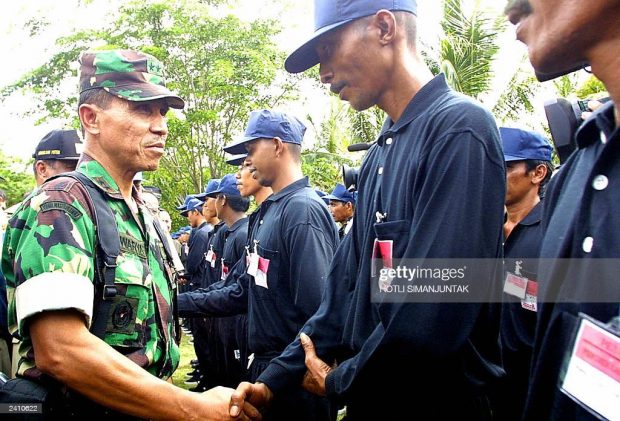
Aceh martial law chief administrator Endang Suwarya (Picture by by Hotli Simanjuntak)
We arrived at the Kartika Inn, Langsa, where journalists, PMI volunteers and soldiers were staying. The regional military emergency authority (PDMD) Maj. Gen. Endang Suwarya and his bodyguards also stayed overnight at the Kartika Inn. Their room was not far from where we had gathered. Apart from PMI, the ICRC delegation also seemed busy. They often hold meetings with PMI, the military and several representatives of RCTI and AJI, looking for the most appropriate formula for the release of the hostages. Ishak Daud’s side, represented by Hamzah and Alfian, was always seen in the negotiations.
When the negotiations at the Regency Building did not reach an agreement, I gathered all the journalists who covered the event, as many as 75 people. I said deadlock negotiations and we were only given until 6 am to return our friends to Langsa. I hope fellow journalists have solidarity together by going into the forest. By the rules of the game, if in the group one car stops, the other cars stop.
Exactly at midnight, we moved side by side. There are 70 cars that go along in the morning so that it invites attention. Arriving in front of the Langsa Kodim, Teguh Juwarno’s car tire exploded. By agreement, all stopped. Langsa Kodim Captain Tatang Sulaiman met me and asked about the purpose of this group. Apparently a car noise in front of the Kodim woke Endang Suwarya and asked the Langsa Kodim about it. Finally, we were asked to enter the Kodim by Panglima Endang Suwarya. The morning talks were crucial for the release of the hostages.
I opened the meeting with the words, “that we must strive for peace without releasing a single bullet and a drop of blood. Now we have to build trust that GAM will keep its promise to release all hostages. But the TNI needs to give Ferry Sontoro an extension of time to follow the traditional release ceremony. I added, the key is now in the hands of Mr. Endang. Tomorrow all the chief editors of the media in Indonesia will meet the TNI commander asking for an extension of time. Meanwhile, we have 75 journalists from all national media who have signed their defense of Mr. Endang if you are removed from office for giving Ferry time to undergo traditional ceremonies”. I added, “Pak Endang, you are now making history. If this peace happens, this step will be the gateway to national peace.”
Apparently Major General Endang Suwarya considered what I said. But the atmosphere is very eerie, touching. All uncertain. Some journalists were crying, worried that the victims would spill back into the forest. Exactly at 03.00 am Major General Endang Suwarya agreed with our proposal to let Ferry come to the traditional ceremony.
We shook hands, hugged. But the army gave one condition, I was not allowed to go into the forest to meet Isaac Daud. I immediately contacted Isaac Daud that we agreed to continue the peace. We sent Ferry for the release ceremony tomorrow, May 15, 2004. Isaac Daud was happy even though he had to stop the troop movement which had begun to be divided into three teams. Technical problems also arise because PMI has returned to Lhoksumawe and Bnda Aceh. I went to the ICRC.
At that time Gozon was in charge, a Spanish citizen. Gozon has been discouraged. I assured them that we got the renewal permit and attended the release ceremony. I also woke up Alfian to accompany Gozon to go up the hill to meet Ishak Daud, because Pak Endang Suwarya was forbidden to meet me. Ferry is in Langsa Military Hospital under special military supervision (Ferry is imprisoned). Again, I had to meet Mr. Endang Suwarya to ask permission to release Ferry. Finally, at 10:00 am Ferry was released and departed for the hill where the GAM agreed to release him traditionally. Exactly in the afternoon at 17.00, the whole team left the negotiation place. Ferry and six journalists left Peurlak. We arrived at Langsa Regent Building, gathered with all military officials, PMI, International Red Cross. Secretary to the Coordinating Minister for Political and Security Affairs, Maj. Gen. Purnawirawan Sudi Silalahi, has returned to Jakarta. We are grateful that peace has finally been achieved without violence.
On May 16, 2004 we left Aceh for Medan, and were welcomed by friends of AJI Medan. We spent the night in the city of Medan. The next day, May 17, 2004, we returned to Jakarta. We handed over the ferry to RCTI friends. The four of us, Nezar Patria, Sholahudin, Husni Arifin and I shook hands and hugged each other with RCTI friends.
We parted ways on the plane we were traveling in before landing at Soekarno Hatta Airport. Teguh Juwarno said, “Why don’t you come to the palace? Ferry Sontoro was invited directly by President Megawati?” I said, “Greetings to the President. I wrote to him for a year without a response.” Teguh smiled and hugged me again.
Arriving at Soekarno Hatta airport, PAN politician Amin Rais welcomed Ferry. Husni Arifin continued his coverage at the palace. Nezar Patria, Sholahudin and I got out of the bustle of the politicians’ welcome. Our humanitarian work is done. We have carried out the organization’s mandate to provide protection for journalists in conflict areas.
Humanitarian duty to free journalists from hostages has paid off. Despite receiving little attention domestically, our efforts were appreciated in international forums. AJI’s name was good at the IFJ congress in Athens, Greece. AJI succeeded in freeing the hostage journalists. Our duty is a humanitarian duty and we have fulfilled it. We don’t just show that journalists’ solidarity in conflict areas is really needed. Violence against journalists in any form must end.

























































